rank Wilson, as well as a rugby player, was a superb all rounder. As
a pupil of the highly regarded Auckland Boys Grammar School, he excelled in cricket,
tennis, swimming, gymnastics and was one of Auckland's fastest track sprinters.
He was also a talented musician and a lover of flowers! He carried on his study at Auckland University and became a School Teacher. Making the most of his University time, Wilson played rugby for the side. Frank captained his Auckland university team in 1914 in the series that was to become known 14 years later as the Gallaher Shield (Premier) Championships, named after the captain of the 1905 'Originals', David Gallaher, who also lost his life in WWI in 1917. The Varsity Club was established in 1888 and historical records at University of Auckland record there was a rugby club in the 1890's, but it had to be unanimously resuscitated annually... and new colours had to be chosen to give the thing a fresh start... upon in 1906 when the Council agreed to the students' suggestion of heraldic blue and silver. A couple of fellow Auckland University Rugby Club members, soon to also be All Blacks signed up for active service in WWI; John Victor Macky, two years after Wilson joined. By this stage Wilson had been dead for almost a year. Macky survived the war. William MacKail Geddis followed Wilson to Gallipoli two months later. He was also promoted to 2nd Lt as was Wilson. Geddis survived the war. Wilson was brought into the Auckland side in 1906 as a 21-year old because of his rare pace. He played for the union in 22 matches up until 1910. He played when Auckland was in the midst of the first great era of the Ranfurly Shield and was involved in nine of the defences. In 1907 Wilson played against fellow 'First XIII' All Black, Jimmy Ridland, who in 1910, debuted with Wilson in their first All Black game in Wellington. Ridland was the last All Black to die in WWI, only six months after leaving New Zealand's shores in 1918. Wilson also would have played against Henry Dewar and Reginald Taylor of Taranaki during a Shield challenge in 1910. Both Dewar and Taylor however weren't All Blacks until three years later. As fate would have it, Wilson and Taylor were to sail on the same ship to Egypt in 1915 and fight at Gallipoli before being split up and sent off to the horrors of the Somme in France where Wilson died. Taylor lasted another nine months before dying at Messines, Belgium in 1917. Dewar had preceded them both in getting to Gallipoli and in death. He died the second day he arrived, on the 9th August 1915, just one day after his mate as fellow All Black, 'Doolan' Downing was killed - the very first All Black to die in WWI. After playing for the North in the 1909 interisland match he was called into the All Black side to tour Australia in 1910 when a number of original selections were forced to withdraw. He earnt selection in 1910, debuting in the warm-up match against Wellington. As with his life, Wilson's involvement with the All Blacks was to be all too brief. He played in the preliminary match before the boat journey across the Tasman, drop kicking a goal in the 26-17 win over Wellington. He was chosen for the opening match in Australia against New South Wales, but late in the match twisted his knee and was put out of the tour and the game itself for good. 14 August 1915... Wilson and Taylor sailed off on the one month journey to Egypt on board either the vessel 'Willochra' or the 'Tofua'. Whichever one it was, they were both together as they were with the 6th Reinforcements. One can just imagine the discussions about rugby they had together. After a short period of training in Egypt, Wilson was transported to Gallipoli to see out the latter part of the campaign. The Gallipoli experience of 1915 however has overshadowed New Zealand's enormous contribution on the Western Front between 1916 and 1918. It was on the Somme that the majority of New Zealanders were killed including Wilson, or wounded during the First World War. And it was here that New Zealand experienced its worst days in military history in terms of loss of life. The Battle of the Somme was New Zealand's first major engagement on the Western Front. It took a huge toll on the 15,000 members of the New Zealand Division who were involved. Roughly one in seven of the division who fought on the Somme was killed, and about four in every ten were wounded. The New Zealand Division came under the command of Lieutenant-General Rawlinson, who commanded the British 4th Army. One of fifteen divisions available to Rawlinson, the New Zealand Division was tasked to capture the village of Flers. New Zealand's Somme experience began on 11 September 1916 when the artillery went into action along with a new 'secret weapon'... The tank made its very first appearance in the war. There was much optimism from British HQ as to the destruction these machines would achieve and on that day they did assist greatly in the advancing the front line another 2km, even though on most occasions the troops ran ahead of the ungainly tanks that could only manage 2 miles an hour! Wilson's Battalion was assigned to the southern flank of Delville Wood and was able to consolidate a position high on the ridge. The tank effort however in High Wood, just to the north-west, was a failure due to the impossible terrain. The Germans were eventually pushed out by the London Territorials but not without huge losses in manpower. By the end of the day, the British Prime Minister's son, Raymond Asquith, had been killed and the future Prime Minister, Harold MacMillan was wounded. The majority of the tanks were either destroyed or immobilised but they had had they effect on the Germans, some witnesses describing how 'Jerry' bobbed up and down in their trenches not knowing what to do until the tanks were on top of them. The original bulge in the lines at Delville Wood had been straightened, ready for the mid-September push. By midnight on the 14th, the New Zealand Division was in place in their trenches around High and Delville woods, about six km north east of the French town of Albert. Morale was high, but the soldiers did not know what to expect. The Somme would be a very different battle from the one Wilson had fought at Gallipoli in the previous year. Here, poison-gas shells, relentless artillery fire and a highly professional opposition took a physical and psychological toll. The New Zealand Division went over the top at 6.20 a.m. on 15 September. All the hundred-odd field guns attached to the New Zealand Division opened fire along the 1000 yards of trench line, which was the infantry's first target. About 6000 of them saw action that day, and although nothing went quite to plan. A bloody struggle involving rifle, bayonet and grenade ensued and the previously impregnable Switch Line was seized. Battalions of the New Zealand Rifle Brigade seized the trench lines around Flers, with the assistance of two tanks. It was an expensive victory, like so many in this war. Some 1200 men of the division were wounded or missing and about 600 were dead. Among the casualties were 52 members of the Pioneer Battalion (which included the Maori Contingent) who were building vital communication trenches under heavy artillery fire. At the time, it was the single worst day in New Zealand's military history in terms of loss of life, but in the following year, it would be surpassed by the horrors of Passchendaele. The gains made on 15 September were not the breakthrough that the Allied command had hoped for. While the New Zealanders had achieved their objectives, English troops on both flanks had not. Consequently, on the 17th September, the New Zealanders were exposed, and German resistance centred on a communication trench, part of which was known as Goose Alley and part as Drop Alley. The next day, both exposed flanks were covered by the London 8th Regiment and the 55th Division. Our casualties at this stage were over 3000. On the 19th (the day Wilson was wounded and later died) the rain was very heavy. Stretcher bearers were struggling in the mud everywhere. Heavy bombardment by the Germans took his life, but not after being wounded and enduring the four hour journey it took by stretcher to the Flers A.D.S through the churned up landscape. The Battle of the Somme was officially declared as being over by General Haig on 19 November 1916 with more than 1,000,000 casualties on both sides. More than 2000 New Zealand bodies lie buried on what was once the battlefield of the Somme, including that of All Black, Frank Wilson. He was buried in Dernancourt, a village 3 kilometres south of Albert. The Communal Cemetery is a little west of the village, and the Extension is on the north-west side of the Communal Cemetery. At the Armistice, the Extension contained more than 1,700 burials. IF YOU HAVE ANY ADDITIONAL INFORMATION ABOUT FRANK WILSON, PLEASE CONTACT US AT info@nixonpictures.co.nz All Black statistics courtesy of the NZ Rugby Museum: |
Video, Television, Corporate, DVD Production and Filming. Based in Auckland, New
Zealand. From concept planning to filming to final output. Over 10 years experience. |
© 2001 Nixon Pictures. Site built & managed by Nixon Pictures. |
solo worldwide |
format required |
rates |
camera operator |
Find out what we're doing or about to do... |

L.B.I.P.P Qualified |
Award Winning |
Nixon Pictures chooses to use Rocket Rentals. |
View online a selection of video clips. |
NEWS |
We have just returned from Western Australia on a 2-week Gone Fishin' shoot. The
team visited Perth, Exmouth and Broome. |
2001 - Best Documentary 2001 - Best Script 2005 - AVA Silver medal |
Documentary making is our passion. Be it a personal ambition or part of someone
else's desire to tell the world their story - we will listen, shoot and give it
all the attention it deserves. Bruce Nixon |
Click to download a PDF version of our CV. |
Experienced & pleasant |
Competitive & flexible |
Able to provide any |
Can direct & operate |
Based in New Zealand |
'All Blacks At War: The First XIII' |
Serial Number 12/2616 Died Tuesday, 19 September 1916, Albert, France. Age 31 Grave Dernancourt Communal Cemetery Extension near Albert Ref: II.B.28. |
FRANK REGINALD WILSON Born 28 May 1885, Auckland. Parents John and Elizabeth Wilson, 12 Pompallier Tce, Ponsonby, Auckland. Education Auckland Grammar. Physical Unknown Province Auckland Rugby Club First made All Blacks from Auckland University. AB# 166 Position Wing three-quarter All Black Debut 3 June 1910 v Wellington, Wellington, aged 25 International Debut June 1910 v NSW, Australia, aged 25. Last Test None Played Rank Second Lieutenant, 1st Battalion, Auckland Infantry Regiment. |
The All Black Games that Wilson played. (+) = substitute; (-) = replaced |
1910 3 Jun vs Wellington at Wellington 26-17 11 Jun vs N.S.W. at Sydney 21-8 |
Points scored for the All Blacks t c p dg pts vs Wellington, 3 Jun 1910 Totals |
F |
Frank Wilson, All Black 1910 |
Frank Wilson, Soldier 1915 |
- - - 1
4 0 0 0 1 4 |
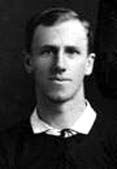
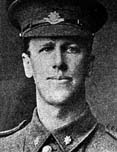
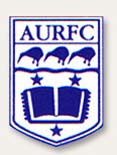
Auckland University Club |

Auckland Grammar School, 1900 |
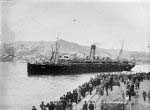
Troop Ship 'Willochra' |

Suez Canal, Egypt, 1915 |
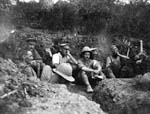
New Zealand Soldiers, Gallipoli, 1915 |

Going 'over the top', Gallipoli, 1915 |
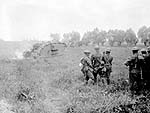
New Zealand officers observing the 'secret weapons' France, 1916 |

A tank at the Battle of the Somme |
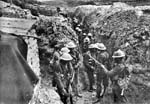
Soldiers prepare at the Somme |
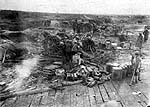
New Zealand Artillery at the Somme |
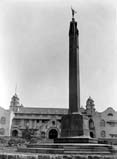
Auckland Boys Grammar School War Memorial |
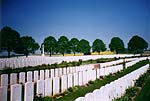
Dernacourt Communal Cemetery Extension, France |
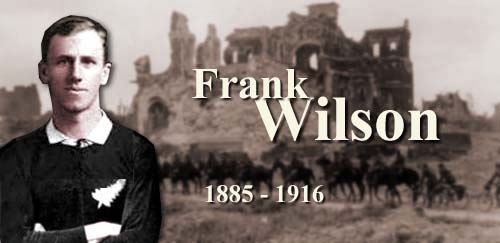
Or visit another of the 'First XIII' |
BACK TO MAIN MENU |